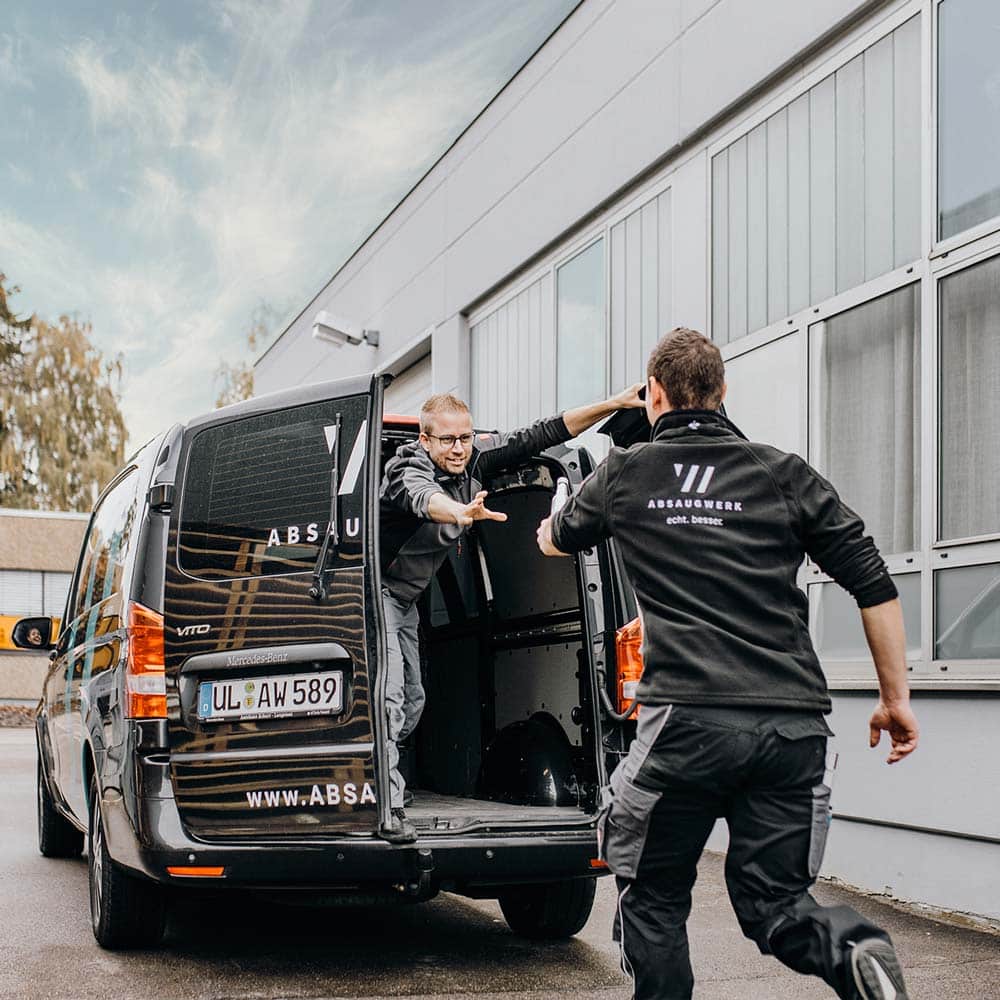
WORKPLACE ORDINANCE
Extraction & extraction systemsObjectives and content of the workplace regulations for extraction systems
The Workplace Ordinance (ArbStättV) serves to protect and ensure the safety of employees when setting up, operating and working in workplaces. The employer must ensure that employees are not exposed to any hazards and that any hazards that still exist represent the lowest possible risk.
What are workplaces?
Factory buildings
Office spaces
Workplaces &
outdoor construction sites
Sales booths
Side rooms &
traffic routes
ArbStättV Goals
The objectives of the regulation are safety at work,
prevention of occupational accidents prevention of occupational diseases.
• Accident prevention
• Occupational safety
• Prevention of occupational diseases
ArbStättV Contents
The Workplace Ordinance – ArbStättV (BGBl. I No. 44 of 24.08.2004, p. 2179) contains minimum regulations for the safety and health protection of employees when setting up and operating workplaces. he ordinance serves the national implementation of the EC Workplace Directive 89/654/EEC.
• Ventilation, air conditioning and lighting conditions
• Sanitary, first-aid, stand-by, break rooms
• Protection of non-smokers
• Escape and rescue routes
• Room dimensions
• Protection against gases and special hazards
• Accessibility
• Display screen work regulation
• Requirements for office workplaces
Safety and health protection
The ArbStättV consists of an enacting part with a total of 10 paragraphs and an annex divided into six sections with requirements for workplaces. The ordinance directly implements the minimum requirements of the aforementioned EU directives.
In the ArbStättV, general protection goals are specified instead of concrete measurements and requirements. This gives the operator more freedom in the implementation and design of the workplace. Particular attention is paid to the safety and health protection of people with disabilities (§ 3a), which companies must meet.
§ 1 Objective, Scope of Application
§ 2 Definitions
§ 3 Risk assessment
§ 3a Setting Up and Operating Workplaces
(safety, health, accessibility)
§ 4 Special Requirements for the Operation of Workplaces (maintenance obligations, keeping escape routes clear, safety equipment, first aid, hygiene)
§ 5 Protection of Non-smokers
§ 6 Instructions for workers (Safety, first aid, health protection, fire prevention)
§ 7 Committee for Workplaces (Tasks of the ASTA)
§ 8 Transitional Regulations
§ 9 Criminal and Administrative Offences (Violation of ArbStättV)
§ 2 Definitions
§ 3 Risk assessment
§ 3a Setting Up and Operating Workplaces
(safety, health, accessibility)
§ 4 Special Requirements for the Operation of Workplaces (maintenance obligations, keeping escape routes clear, safety equipment, first aid, hygiene)
§ 5 Protection of Non-smokers
§ 6 Instructions for workers (Safety, first aid, health protection, fire prevention)
§ 7 Committee for Workplaces (Tasks of the ASTA)
§ 8 Transitional Regulations
§ 9 Criminal and Administrative Offences (Violation of ArbStättV)
Validity
The ArbStättV covers all places, both inside buildings and outdoors, which are located on company premises and to which employees have access in the course of their work. This also includes construction sites and vehicles.
- Vehicles on the company premises (e.g. factory traffic, forklift trucks)
- Outdoor sales stands in front of department stores
- Offices with desk sharing
- Accommodation on construction sites
Excluded from the scope of the ArbStättV are:
- Mining companies
- Tele- and home workplaces
- Mobile work in company vehicles
- Workplaces in itinerant and market traffic
- Agricultural and forestry operations outside built-up areas
- Means of public transport (road, rail, air)
Of the reported accidents, a not insignificant portion are due to the improper condition, setup, and maintenance of workplaces…
Source: baua (Federal Institute for Occupational Safety and Health)
Occupational safety and health (OSH)
In accordance with § 4 of the German Occupational Health and Safety Act, the OSH reflect the state of the art, occupational medicine and occupational hygiene as well as the other established occupational science findings for the setting up and operation of workplaces. The individual guidelines are drawn up by the Committee for Workplaces (ASTA) and come into force after publication by the Federal Ministry of Labor and Social Affairs in the Joint Ministerial Gazette (GMBI). If the operator chooses a solution that deviates from the ASR, it must at least meet the same requirements that the OSH specifies.
ASR V3
Risk assessment
Issue: July 2017
(GMBl 2017, p. 390)
ASR V3a.2
Barrier-free design of workplaces
Issue: August 2012
(GMBl 2012, p. 663, last amended GMBl 2022, p. 240)
ASR A1.2
Room dimensions and movement areas
Issue: September 2013
(GMBl 2013, p. 910, last amended GMBl 2022, p. 241)
ASR A1.3
Safety and health protection labeling
Issue: February 2013
(GMBl 2013, p. 334, last amended GMBl 2022, p. 242)
ASR A1.5
Floors
Issue: March 2022
(GMBl 2022, p. 199)
ASR A1.6
Windows, skylights, translucent walls
Issue: January 2012
(GMBl 2012, p. 5, last amended GMBl 2022, p. 244)
ASR A1.7
Doors and gates
Issue: November 2009
(GMBl 2009, p. 1619, last amended GMBl 2022, p. 244
ASR A1.8
traffic routes
Issue: March 2022
(GMBl 2022, p. 214)
ASR A2.1
Protection against falling and falling objects, entering danger zones
Issue: November 2012
(GMBl 2012, p. 1220, last amended GMBl 2022, p. 245)
ASR A2.2
Escape routes and emergency exits
Issue: March 2022
(GMBl 2022, p. 227)
ASR A3.4
Lighting
Issue: April 2011
(GMBl 2011, p. 303, last amended GMBl 2022, p. 248)
ASR A3.4/7
Safety lighting, optical safety guidance systems
– canceled –
(GMBl 2022, p. 248)
ASR A3.5
room temperature
Issue: June 2010
(GMBl 2010, p. 751, last amended GMBl 2022, p. 198)
ASR A3.6
Ventilation
Issue: January 2012
(GMBl 2012, p. 92, last amended GMBl 2018, p. 474
ASR A3.7
Noise
Issue: March 2021
(GMBl 2021, p. 543)
ASR A4.1
Sanitary facilities
Issue: September 2013
(GMBl 2013, p. 919, last amended GMBl 2022, p. 212)
ASR A4.2
Break and standby rooms
Issue: August 2012
(GMBl 2012, p. 660, last amended GMBl 2022, p. 251)
ASR A4.3
First aid rooms, first aid equipment and facilities
Issue: December 2010
(GMBl 2010, p. 1764, last amended GMBl 2022, p. 252)
ASR A4.4
Accommodation
Issue: June 2010
(GMBl 2010, p. 751, last amended GMBl 2022, p. 212)
ASR A5.2
Requirements for workplaces and traffic routes on construction sites
in the border area with road traffic – roadworks
Issue: December 2018
(GMBl 2018, p. 1160, last amended GMBl 2022, p. 252)
Implementation
The basis for implementing the measures within a company is the so-called anticipatory risk assessment, which must be carried out before the activities are performed. Depending on the federal state, supervision is the responsibility of the trade supervisory office or the office for occupational safety (BaWü district office or city district, NRW district government). The inspections are unannounced and, in the event of non-compliance, can lead to fines or even the shutdown of a company, but in any case represent an administrative offense. The employers’ liability insurance associations also fulfill a prevention mandate with regard to accident prevention regulations and thus contribute to the practical implementation of the ArbStättV.
Legal certainty
If measures have been implemented taking into account the OSH, aspects of the current state of the art, occupational medicine and hygiene, regulations and standards of the employers’ liability insurance association, and scientific findings, it can be assumed that the protection goals have been achieved and that there is legal certainty for the employer.
Participation rights
In companies, works councils, staff councils, representatives of the severely disabled and equal opportunity representatives have the right to actively participate in shaping the workplace both in the planning phase and during ongoing operations. If there is no works council, all employees must be consulted about safety and health measures and not just informed.
Overview of the occupational safety and health regulations (OSH) and associated superseded workplace directives for the former Workplace Ordinance of 1975.
Get individual advice
We can help you find the best extraction solution for your production facility.
Feel free to contact us.
FAQs
Are extraction systems subject to approval?
Extraction systems are subject to approval if they are larger extraction systems whose system components
- require their own foundation, or
- are permanently attached to a building, or
- may pass through several fire compartments, or
- convey air pollutants outdoors and release them into the environment, or
- work with wet separators and produce both sludge and wastewater as by-products,
it must be checked on a case-by-case basis together with the competent authority whether a permit must be obtained before the installation is erected.
There is a so-called model building code at federal level, but only the state building codes of the individual federal states are legally binding. Competent authorities can be municipal, city or district authorities.
What is important for an extraction system?
The suction capacity of an extraction system is measured in volume flow and describes how much air can flow through a pipe or extraction system in a certain time. Resistance and deposits in the extraction system or the pipe system have a negative effect on the volume flow.
In addition to performance, the extraction elements such as extraction arms, extraction hoods or extraction tables are also crucial for effective extraction. If the dust or welding fumes are not captured effectively, they spread throughout the hall and pollute the air we breathe. Furthermore, no deposits may form in the pipes, as this reduces the filter performance and can cause serious fires.
What do I have to consider legally with an extraction system?
- Legal regulations & standards
- Environmental protection regulations
- Occupational health and safety regulations
- Approvals / Certifications
- Maintenance & inspection
When is suction effective?
Effective extraction can only take place if the release or emission source is located within the suction field of the capture element (extraction arm, extraction hood, etc.) and the extraction unit / filter system can provide sufficient suction power. The right registration element, user-friendliness and proper use by employees play a decisive role here.
- Effective detection, as close as possible to the source of origin
- Sufficient suction power and suitable filter elements
- User-friendliness and proper use by personnel

